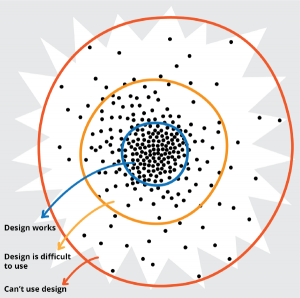9 Designing with Accessibility, Inclusion, Diversity in Mind
Where to begin?
If we knew how to, and if we had easy-to-use tools, we’d all make our content more accessible, more inclusive, more adaptable, and more configurable to individual learner needs. Of course, authoring content in an accessible application from the beginning helps achieve these goals best and makes the content more adaptable. There are also options for making materials more accessible “after the fact”.
In either case, making content more inclusive begins with understanding what kinds of alternatives are needed, and realizing that inclusivity and accessibility are achieved through awareness, adaptation, collaboration, and flexibility. There is no definitive checklist, no machine that churns out accessible materials. With awareness and the tools, we can commit to making our materials more inclusive and more accessible.
“Where to Begin” by The Floe Inclusive Learning Design Handbook is licensed under CC BY 2.5 CA.
What is inclusive design?
Watch this 1-minute introduction to inclusive design. The transcript can be found below the video.
What is Inclusive Design on YouTube
The Inclusive Design Research Centre (IDRC) provides the following definition of inclusive design: “design that considers the full range of human diversity with respect to ability, language, culture, gender, age and other forms of human difference.” The IDRC also stresses three dimensions of inclusive design. Take a moment to learn more about each dimension by clicking on the hotspots (question marks) in the following H5P activity. If you prefer, you can access this resource as a text-based version of the three dimensions of inclusive design.
Three Dimensions of Inclusive Design
Innovation at the edges
Learners learn differently. The goal of education is to support learners in reaching their full potential. While part of the educational process is to challenge learners to facilitate their growth, many learners experience constraints that make it difficult if not impossible to access certain learning resources.
These potential barriers to learning can include:
- sensory, motor, cognitive, emotional and social constraints
- individual learning approaches or preferences
- linguistic or cultural preferences
- technical, financial or environmental constraints
Where to begin? by the Inclusive Design Research Centre is licensed under CC BY 2.5 CA .
Innovation at the Edges by community members of the Inclusive Design Research Centre at OCAD University is licensed under CC BY 3.

This starburst plot shows a denser set of dots (representing the majority needs) in the centre, and more widely spaced dots the further you get from that centre (the minority needs). Distance represents difference. The closer the dots the more similar they are. The wider they are spaced from each other the more they differ. Design innovation happens at the outer edges.
When we have limited time and resources, we tend to follow the 80/20 rule; to tackle the 80% (majority needs) first, and leave the most difficult 20% (minority needs) for later. However, change and innovation are found at the margins. Designing for the 20% might take more time and resources at first, but it will be dynamically resilient and adaptable, and will also cost less in the long term.
The Inclusive Design Guide created by the community membersof the Inclusive Design Research Centreat OCAD University is licensed under CC BY 3.0.
Dimensions of diversity
Think back to your OER vision that you worked on in the first week of this OER Design Incubator. Who are your learners? Who are you creating these OER resources for? Let’s begin to identify the different dimensions of learner diversity.
Intersectionality
Intersectionality was originally defined by Dr. Kimberlé Crenshaw (1989): Intersectionality promotes an understanding of human beings as shaped by the interaction of different social locations (i.e. race, gender, sexual orientation, geography, age, disability, migration status, religion).
Think about how the identity of each of your learners represents a unique intersection of multiple dimensions of diversity.
The Process: The virtuous tornado
Rather than moving toward a single design solution, inclusive design is an iterative process that expands a design to encompass more possibility, more means of access, and more inclusive dimensions. The virtuous tornado, shown in the image below, describes an upward spiral into which needs and characteristics are injected at each design iteration. As the design moves up the spiral it expands to encompass these needs, becoming more and more inclusive in the process.
You can start small; each time you circle around and up the spiral you will be stretching the design to encompass more and more needs, and moving outward toward the edge of the starburst. It is also about balance and flexibility: creating a design that does not compromise the experience of one person to make room for the requirements of another. If you are able to change your design to meet the needs of at least one additional person, you are moving in the right direction.
The Inclusive Design Guide created by the community members of the Inclusive Design Research Centre at OCAD University is licensed under CC BY 3.0.
What can we do to make our OER content more inclusive?
The beautiful thing about OERs is that we can continually work to make our content more inclusive.
Work through the following accordion menu that highlights areas and elements where diversity, equity, and inclusivity are most relevant and visible within textbooks. Think about how you can adapt any OERs you have found, or what inclusive design elements you will include as you create new OERs.
Accordion menu content is from Improving Representation and Diversity in OER Materials by Rice University is licensed under CC BY 4.0.
Inclusive design resources
- Open Educational Resources: Diversity, Equity, and Inclusion in OER
- The Floe Inclusive Learning Design Handbook
- Diversity and Inclusion in Open Education
References
Crenshaw, Kimberle () “Demarginalizing the Intersection of Race and Sex: A Black Feminist Critique of Antidiscrimination Doctrine, Feminist Theory and Antiracist Politics,” University of Chicago Legal Forum: Vol. 1989: Iss. 1, Article 8. Available at: http://chicagounbound.uchicago.edu/uclf/vol1989/iss1/8.

